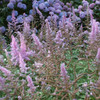

WELCOME BACK!
Our earliest available ship date is the week of April 14th.
Please note your preferred ship date/week in the "Order Comments" section at checkout.
See the "Shipping" page under "Company Information" for our default ship dates based on hardiness zone.
We are unable to ship to any US Territories, AK, AZ, CA, CO, HI, ID, MT, NM, NV, OR, UT, WA, or WY
Low growing, slowly spreading wide into groundcovering mat. Tolerates more drought than most of other Astilbe. RHS Award of Garden Merit.
Flowers with fragrant, pale purple-pink panicles in mid- to late summer that persist as dried seedheads till fall-early winter. Dwarf Astilbe, spreads relatively quickly (compared to other Astilbes) via rhizomes. Dark green, ornamental foliage is cut and can remind of ferns
Low maintenance perennial, no serious pests or disease (the only work is to clean the leaves in the prespring). Clumps may want to be divided every 3-4 years
The other used name is Astilbe chinensis var. pumila; other common names include False Spirea, False Goat’s Beard.
Blooming Time : mid to late July - August. This species of Astilbe blooms later than others.
Size: up to 12" tall and wide and slowly spreading wide
USDA Zones: 4 to 8
Culture: half to full shade; rich, sandy, clay, or slightly acidic soil, prefers some drainage, heat, humidity and drought tolerant.
Moisture Needs: average to moist
Origin: Tibet (southwestern China)
Black Walnut Tolerant: yes
Deer/Rabbit Resistant: yes / yes
Attracts Butterflies or Pollinators: yes
Attracts Hummingbirds: no
Pot Size: square 3.5" x 4" deep
Plant Combinations: Goes well with most of the partial shade/shade loving perennials, groundcovers and smaller to medium-sized shrubs. Looks the best combined with (slightly) more robust/rough structures - for example with big leaves of Alchemilla, Anemone hupehensis (japonica hybrids), Bergenia, Brunnera, Heuchera, Hosta, Phlox paniculata hybrids (in half shade), Podophyllum, Polygonatum (Solomon's Seal), Pulmonaria, Tradescantia.
Other good companion can be Actaea (Cimicifuga), Ajuga, Aquilegia, Astrantia (in cooler areas), Chelone lyonii, Chrysogonum, Dicentra spectabilis, Digitalis, Euphorbia amygdaloides, Eupatorium rugosum 'Chocolate', Geranium hybrids, Geranium maculatum, Geum, Lamium, Galium, Polemonium, Primula, Tricyrtis, Waldsteinia and grasses like Carex (both very narrow-leaved or wide-leaved) or Hakonchloa.
.
Picture Copyright: US Perennials
Low growing, slowly spreading wide into groundcovering mat. Tolerates more drought than most of other Astilbe. RHS Award of Garden Merit.
Flowers with fragrant, pale purple-pink panicles in mid- to late summer that persist as dried seedheads till fall-early winter. Dwarf Astilbe, spreads relatively quickly (compared to other Astilbes) via rhizomes. Dark green, ornamental foliage is cut and can remind of ferns
Low maintenance perennial, no serious pests or disease (the only work is to clean the leaves in the prespring). Clumps may want to be divided every 3-4 years
The other used name is Astilbe chinensis var. pumila; other common names include False Spirea, False Goat’s Beard.
Blooming Time : mid to late July - August. This species of Astilbe blooms later than others.
Size: up to 12" tall and wide and slowly spreading wide
USDA Zones: 4 to 8
Culture: half to full shade; rich, sandy, clay, or slightly acidic soil, prefers some drainage, heat, humidity and drought tolerant.
Moisture Needs: average to moist
Origin: Tibet (southwestern China)
Black Walnut Tolerant: yes
Deer/Rabbit Resistant: yes / yes
Attracts Butterflies or Pollinators: yes
Attracts Hummingbirds: no
Pot Size: square 3.5" x 4" deep
Plant Combinations: Goes well with most of the partial shade/shade loving perennials, groundcovers and smaller to medium-sized shrubs. Looks the best combined with (slightly) more robust/rough structures - for example with big leaves of Alchemilla, Anemone hupehensis (japonica hybrids), Bergenia, Brunnera, Heuchera, Hosta, Phlox paniculata hybrids (in half shade), Podophyllum, Polygonatum (Solomon's Seal), Pulmonaria, Tradescantia.
Other good companion can be Actaea (Cimicifuga), Ajuga, Aquilegia, Astrantia (in cooler areas), Chelone lyonii, Chrysogonum, Dicentra spectabilis, Digitalis, Euphorbia amygdaloides, Eupatorium rugosum 'Chocolate', Geranium hybrids, Geranium maculatum, Geum, Lamium, Galium, Polemonium, Primula, Tricyrtis, Waldsteinia and grasses like Carex (both very narrow-leaved or wide-leaved) or Hakonchloa.
.
Picture Copyright: US Perennials
